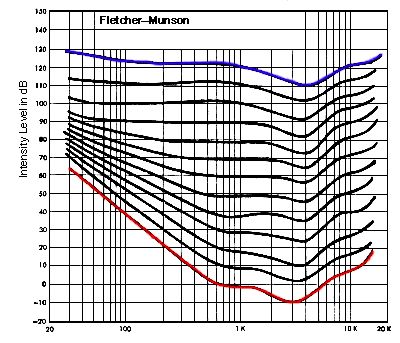Beautiful curves: Fletcher and Munson
FLETCHER-MUNSON: keep that V-shaped EQ for the bedroom!
Why is it necessary to use a bigger amp for the bass than for the guitar when gigging?
Why do some amps have a bright switch when you could just turn the "high" knob up?
The answer to all these questions (and more) is very simple and lies in a few curves. And you don't even have to be a rocket scientist to understand them!
The Fletcher Munson curves date back to the 1930s and were traced by conducting many earing tests. They indicate for each frequency how much acoustical pressure is needed for an equal loudness. To put it simply: each curve indicates how much energy you need to make each frequency heard at the same level.

These curves show that not only does the necessary energy (or power) needed for equal loudness changes with the frequency, but also that this variation varies with the sound level!
Looking at the red curve, we can see that a pure 100hZ tone needs a level of 40dB to be heard at the same perceived level as a 1kHz tone at a level 0db.
If we look now at the blue curve, we note that a 125dB level is needed at 100Hz to hear it as loud as a 4kHz at 110dB.
It is possible to draw many conclusions from these curves but the following two are the most interesting for us:
1. At low volume, it is necessary to turn the highs and lows up to hear them at the same level as the mids.
2. The higher the volume, the better we comparatively hear the highs and lows, although still not as well as the mids.
From these two principles, we can explain many "mysteries" and better understand how to use our gear:
Why does a V-shaped equalization seem to give a "big" sound?
When we play at low volume with a flat EQ, we mainly hear the mids. By turning the mids down, not only do we ear them better (principle 1), but we trick the ear into thinking that the music is played loud even though the level remains the same because the music's frequency curve now resembles the one we would have if we played the music louder (principle 2).
Why is it more satisfying to play guitar with a loud amp than quietly?
The answer is similar to the previous one. When we increase the volume on the amp while keeping the same EQ settings (with a good amp of course), we get the impression that the highs and lows become louder comparatively to the mids (principle 2): the tone seems "bigger" (thanks to the more prominent lows) and more detailed (thanks to the more prominent highs).
Why is it necessary to use a bigger amp for the bass than for the guitar when gigging?
We can see that whatever the sound level, we never hear the lows as well as the mids (principles 1 and 2). It is therefore necessary to use more power for the bass in order to make it perceived loud enough (as loud as the guitars for ex.).
Why do some amps have a bright switch when you could just turn the "high" knob up?
Nowadays, it is often used to create a special effect, but the first aim of that switch was to compensate for the perceived lack of highs at low volume with a very low parts count (principle 1). Compensating the lack of lows is a much more complicated task necessitating a proper dedicated circuit so this is very rarely implemented on amplifiers. But hi-fi equipment and car stereos often have this feature: it is often called "Loudness".
Many other questions find their answer in these two principles. For discussions sake, it is also interesting to note that the human voice register spans across the medium frequency range: pure hazard or illustration of the Darwinian evolution theory?


